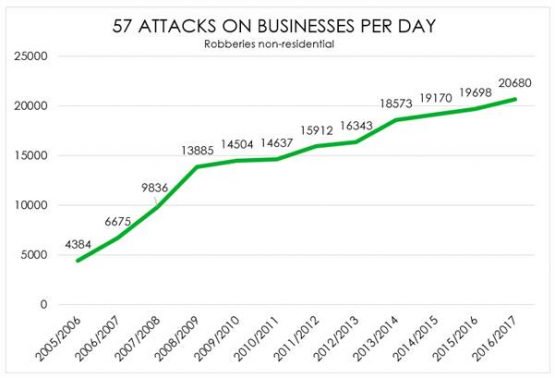A warning light for the retail sector.

The 2016/2017 crime statistics released on Tuesday make for a sobering reminder that South Africa’s battle against syndicated and organised criminal activity is far from over.
“With a record high of 20 680 armed robberies against business recorded, South Africa is experiencing 57 attacks per day. This figure should prompt critical intervention by industry and government,” says Richard Phillips, joint CEO of Cash Connect.

Source: Cash Connect
Cash-related crime has increased yet again, sounding an alarm that the mitigation of cash crime should be prioritised.
Business robberies increased by 4.9% from 19 698 in 2015/2016 to 20 680 for the last year, while the business burglaries figure also shows an upward spiral with 75 618 burglaries in 2016/2017.
Following a new-millennium low of 119 robberies reported in the 2014/2015 national statistics, the 2016/2017 graph shows an increase of 11% with 152 cash in transit (CIT) robberies.
The South African Banking Risk Information Centre (Sabric) chief executive Kalyani Pillay earlier this month revealed that the organisation had recorded 232 CIT incidents nationally this year from January 1 to August 31. “An increase of 49% is evident when comparing this year to the same period last year,” Pillay said. “There is much concern at the number of injuries and fatalities among CIT staff, as well as the damage caused to CIT vehicles in the incidents where criminals use explosives during these attacks.”

Source: Cash Connect
Poverty statistics released by Stats SA a few weeks ago confirm the high unemployment rate and aggravated poverty prevailing in our country. “While it would seem logical to ascribe the high levels of cash crime to the poverty rate, along with other factors like weak economic growth, continuing high unemployment levels, lower commodity prices, higher consumer prices (especially for energy and food), lower investment levels, greater household dependency on credit, and policy uncertainty, I am not convinced that this is an accurate assumption. I am of the opinion that the real issue is the re-emergence of organised criminal syndicates on our streets,” Phillips notes.
“Professional and habitual criminals who are extremely well organised, skilled and financed, are attacking the retail sector, the CIT sector, as well as banks and ATMs in pursuit of large quantities of cash.”
Phillips says the big issue remains the prioritisation of cash crimes. “The SA Police Service has to ensure that crime intelligence, policing, the NPA and the courts collaborate with the cash industry in the interests of safeguarding the cash that feeds the retail and commercial economy,” he says.
Based on past lessons and information contained in crime statistics, investment in three areas could be the answer for the retail and CIT industries.
Crime fighting
According to Dr Johan Burger, senior researcher at the Institute for Security Studies, we must draw on lessons of the past. The priority crime initiative on bank and CIT crime, which was led by the South African Police Services and operated for at least six years through the turn of the century, was a cornerstone of the multi-faceted approach that brought CIT and other cash-related crimes under control before.
“South Africa reeled under 700 to 800 attacks a year in the 1990s,” Burger says. “Crime intelligence and a tightly coordinated, professional response strategy worked then, and will again.”
Burger’s words are borne out by the far better flow of information and increase in arrests that have resulted from the task force the Minister of Police established in 2016 to focus on business crime and cash robberies.
“But more needs to be done,” he says. “The CIT providers, and indeed retailers and the banking industry as well, have to keep lobbying the justice cluster to operationalise the prioritisation of bank and CIT crime, and start working much closer with the industry to contain syndicated and organised crime. Fighting this type of crime has to be at least as sophisticated as the planning and execution that make it possible.”
CIT investment in R&D
In recent years CIT providers have, ironically, become cash strapped. The rate to provide a client with CIT services has declined to the point where service fees no longer keep track with inflation.
“The margins that previously were available for R&D are simply not there anymore,” says Phillips. “And as risks and attacks increase, our insurance costs skyrocket. In the meantime, the syndicates keep refining their methods and are becoming more successful and, consequently, more brazen again.”
The case for sustained R&D is well proven. “The cash industry is of strategic importance to the South African economy,” says Phillips. “Around 84% of all payments are still made in cash; we have R130 billion worth of cash in circulation.” Against this backdrop, Phillips believes minimum CIT operating standards and service fees should be a matter of legislation.
Prevention starts on the shop floor
Research has shown that a staggering 90% of attacks on businesses are carried out with information gained from the inside. This suggests that employers can play a far greater role in safeguarding their own businesses by engaging with the people who work for them and investing in better workplace relationships.
Mari Lee, CEO of DevCom, a communication agency that specialises in helping businesses to change their processes to engage employees and external stakeholders in ways that directly contribute to the achievement of business results, agrees. “The dozens of research projects we’ve done over the years confirmed again and again that employees who feel respected, valued and listened to will do what is best for their company. Retailers should be motivated by the intelligence in the crime stats to invest time, effort and money in meaningful employee engagement.”
Phillips concludes that South Africa’s retail and CIT sectors are desperate for a critical intervention to curb cash crime. By pushing for a coordinated approach of sharing crucial information among industry bodies and investing in crime intelligence, technology improvements and labour relations, the tide can be turned.
Brought to you by Moneyweb
Download our app




